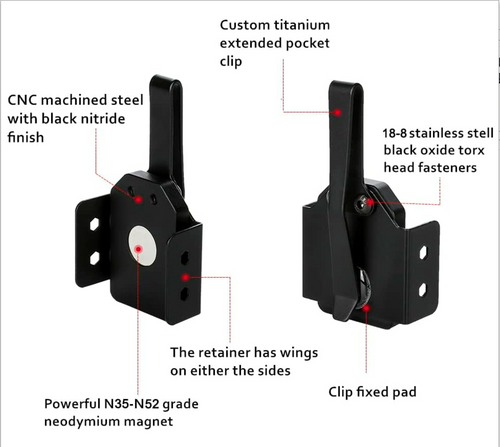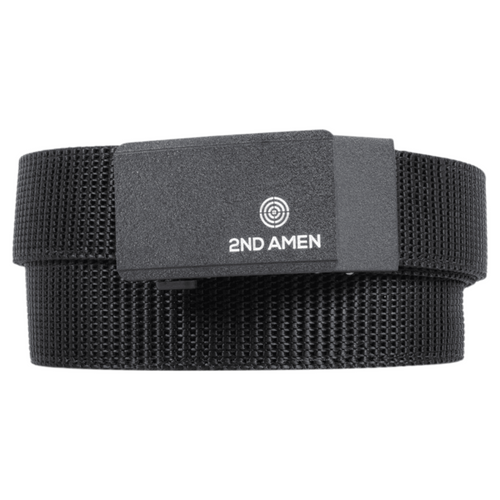Want a holster that’s comfortable, secure, and easy to draw from? Here’s how to test holster fit for everyday carry:
- Comfort: Ensure the holster feels natural against your body during activities like sitting, walking, or bending. Adjust the height, angle, and position for the best fit.
- Security: Test retention by jumping, running, and shaking the holstered firearm. It should stay secure but allow a smooth draw.
- Accessibility: Practice drawing your firearm while wearing everyday clothes. You should get a full grip without fumbling.
Follow these steps to fine-tune your holster for safe and effective carry.
Getting Ready for Fit Testing
Safety First: Unload and Check
Before anything else, make sure your firearm is safe to handle. Remove the magazine and clear the chamber. Take an extra moment to visually and physically confirm that both the chamber and magazine well are empty. For added security, you can use a chamber flag or safety block. Always keep your finger off the trigger and stay mindful of where the muzzle is pointed throughout the process.
Dress for Daily Use
Once your firearm is confirmed safe, gear up in the clothes you typically wear when carrying. This includes:
- Your everyday belt
- Pants
- Layers (like an undershirt and overshirt)
- Footwear
If your holster has adjustable features, take note of how these settings impact both comfort and concealment. At this point, decide on your preferred carry position.
Choose Carry Position
Begin by placing your holster in the general area of your preferred position. For inside-the-waistband (IWB) carry, popular positions include:
- Strong-side: Around 3 to 5 o’clock for right-handed users
- Appendix: Between 12 and 2 o’clock
- Cross-draw: Between 10 and 11 o’clock for right-handed users
The Houdini Holsters' Breakout 2.0 IWB holster, with its patent-pending design, allows for precise adjustments while ensuring your firearm stays secure. Align the holster carefully - it may take a few tries to find the right spot. Proper alignment is key to assessing both comfort and accessibility.
Once the holster is positioned, move around to test how it feels during everyday activities.
Holster Setup 101: Balancing Concealment and Comfort for ...
Testing Comfort Level
Assess how the holster feels during everyday activities to ensure it suits your needs.
Movement Tests
Check for any discomfort or pressure points during common movements:
- Sitting: Try sitting in various chairs - like an office chair, car seat, or dining chair. Pay attention to any areas where the holster causes discomfort as you shift positions.
- Walking: Notice if the holster moves around or creates friction while you walk.
- Bending: Bend over, reach for objects, or tie your shoes to see if the holster digs into your side or becomes uncomfortable.
Position Adjustments
Fine-tune the holster's position to balance accessibility and comfort:
- Height: Adjust the ride height to allow for easy access without interfering with your movements.
- Cant Angle: Experiment with the angle to find one that feels natural and supports both concealment and a smooth draw.
- Belt Position: Shift the holster along your belt until you achieve the best combination of comfort and accessibility.
Once adjusted, ensure the holster stays in place during movement.
Movement Stability
Put the holster to the test with dynamic activities to confirm it stays secure:
- Quick Turns: Make sharp turns to check if the holster remains stable.
- Stair Navigation: Walk up and down stairs, observing if the holster shifts or causes discomfort.
- Vehicle Entry/Exit: Get in and out of your vehicle multiple times to ensure the holster stays securely in place.
Checking Security Features
Once you've ensured comfort, the next step is to evaluate your holster's ability to securely hold your firearm. The Breakout 2.0 IWB holster is designed with adjustable retention, offering both safety and quick access. You can test these features through controlled, active movements to ensure reliable performance.
Active Movement Check
Evaluate the holster's security during various physical activities:
- Jump Test: Do a few small jumps to see if the firearm stays securely in place.
- Running Motion: Jog in place for 30 seconds to check retention during more vigorous movement.
- Twist and Bend: Rotate your torso and bend at different angles to monitor whether the firearm shifts or loosens.
Watch closely for any unwanted movement or signs of instability. A properly secured firearm should stay firmly in place without any noticeable shifting.
Retention Strength
Retention strength is a key factor in safe carry. Here's how to test it:
- Hold the holstered firearm upside down - ensure it stays securely in place.
- Give the holster a firm shake - it should resist movement.
- Test the draw - it should require deliberate effort but still feel smooth and controlled.
Retention Adjustment
Fine-tuning the retention settings ensures the perfect balance between security and accessibility:
- Start by setting the retention screws to medium tension. You should hear a clear, audible click when the firearm is fully seated.
- Adjust in small increments (1/4 turns) and test after each adjustment.
- The final setting should keep the firearm secure, provide smooth draws, and offer clear tactile feedback.
Retention settings may need occasional adjustments as the holster breaks in over time. The Breakout 2.0's patent-pending system allows for precise tweaks without compromising safety or draw efficiency. Regular checks can help maintain optimal performance.
sbb-itb-7fb5bb8
Draw Speed and Access
Testing draw speed and accessibility is critical for ensuring your holster performs as intended. A good holster should allow for smooth, reliable draws while keeping your firearm secure. The Breakout 2.0 IWB holster by Houdini Holsters (https://houdiniholsters.com) is designed to balance quick access with dependable retention.
Draw Practice
Start with an unloaded firearm to safely practice your draw technique. Wear your usual daily clothing and focus on achieving a steady, secure firing grip every time.
Here’s how to break down the draw process:
- Grip establishment: Move clothing out of the way and firmly grasp the firearm with a complete firing grip.
- Initial draw: Clear the holster retention smoothly and pull the firearm free.
- Presentation: Raise the firearm into a ready-to-fire position.
Practicing these steps repeatedly will help you develop muscle memory and ensure consistent performance.
Grip Access
Check how easily you can establish a proper grip with your holster by assessing:
- Grip angle: Your hand should naturally align into the correct firing position as you draw.
- Thumb break access: If your holster has a thumb break, make sure it releases quickly and reliably.
- Full firing grip: Ensure you can achieve a secure and complete grip before the firearm leaves the holster.
The Breakout 2.0 IWB holster’s cant angle is designed to support natural grip acquisition without sacrificing concealment. Test your grip from different positions - standing, sitting, or moving - to confirm reliability. Once you’re confident in grip access, shift your focus to safe reholstering.
Reholster Safety
Follow these steps for safe and effective reholstering:
- Keep your eyes on the holster to confirm proper alignment.
- Ensure no clothing or objects block the holster opening.
- Feel for the firearm to securely lock into place.
- Practice reholstering with your dominant hand to build muscle memory.
Run through several draw-and-reholster cycles to ensure the holster maintains its shape and doesn’t create unnecessary resistance.
Safety tips to keep in mind:
- Practice in a controlled, designated area.
- Keep your finger off the trigger until ready to fire.
- Maintain proper muzzle discipline at all times.
- Focus on smooth, controlled movements for both drawing and reholstering.
Final Adjustments
Refining your setup ensures the Breakout 2.0 IWB holster meets your personal carry preferences. Its adjustable features make it easy to tailor for comfort, concealment, and accessibility.
Position Adjustments
Fine-tune the holster's position for the best fit:
- Height: Adjust in 1/4-inch increments to balance concealment and accessibility.
- Cant angle: Experiment with angles from 0 to 15 degrees to suit your body shape and drawing motion.
- Ride depth: Position the firearm closer or farther from your body to enhance grip access and concealment.
Test these adjustments by sitting, standing, and walking to ensure everything feels right.
Component Adjustments
Customize these key components for optimal performance:
- Retention screws: Tighten or loosen until you hear a clear "click" when holstering, while keeping the draw smooth.
- Belt clips: Adjust the clips to evenly distribute weight and prevent the holster from shifting.
- Comfort wedge: If using one, place it to improve both concealment and comfort.
Make small adjustments - around 1/4 turn at a time - to avoid over-tightening. Test each change thoroughly to confirm it works as intended.
Final Testing
Wrap up the setup process with a systematic test to ensure everything is dialed in.
1. Stability check
Move deliberately to confirm the holster remains secure, with proper retention and easy grip access.
2. Comfort check
Perform dynamic movements to assess comfort during daily activities.
3. Retention test
Test the holster's retention strength by:
- Doing jumping jacks
- Making quick directional changes
- Leaning forward or mimicking inverted positions
If anything feels off after testing, revisit the adjustments until you achieve the right balance of comfort, security, and accessibility. A properly fitted holster is essential for effective everyday carry.
Conclusion: Confirming Proper Fit
After fine-tuning your holster, it's time to ensure it's ready for everyday use. A properly fitted holster is crucial for safe and effective carry. Once you've adjusted your Houdini Holsters Breakout 2.0 IWB holster, perform these final checks:
Daily Activity Simulation
Spend about 15 minutes mimicking your usual daily movements. Pay attention to any spots that feel uncomfortable or restrictive.
Retention and Security Test
Make sure your firearm stays securely in place during different motions. It should remain holstered unless you intentionally draw it. Test that it’s both secure and easy to access when needed.
Ease of Access
Check that you can:
- Get a full firing grip and draw smoothly
- Access your firearm comfortably whether standing or sitting
Comfort Check
Your holster should feel stable but not restrictive. If you notice any discomfort or pressure points, make further adjustments.
FAQs
How can I make sure my holster stays comfortable for all-day concealed carry?
To ensure your holster remains comfortable during extended wear, start by selecting a holster designed with comfort in mind, such as those made from high-quality materials that reduce friction and pressure points. Proper fit is essential - your holster should securely hold your handgun without digging into your body or shifting throughout the day.
Adjust the holster's position on your body to find the most ergonomic placement, typically around the 3 to 5 o’clock position for IWB (inside the waistband) holsters. Additionally, wearing a sturdy, purpose-built gun belt can help distribute the weight evenly and prevent sagging. If you’re using a holster like the Breakout 2.0 IWB from Houdini Holsters, its design prioritizes both concealment and comfort, making it ideal for long-term wear. Remember, small adjustments can make a big difference in your daily carry experience.
What should I do if my holster feels unstable during movement?
If your holster feels unstable during active movements, it’s important to address the issue to ensure safety, comfort, and proper concealment. Start by checking the holster’s attachment system - ensure clips, loops, or other fasteners are securely attached to your belt and positioned correctly. A high-quality gun belt designed for concealed carry can also improve stability.
Next, evaluate the holster’s fit for your specific handgun. A loose or improper fit can cause instability. If adjustments are possible, such as tightening retention screws, make those changes to improve the hold. For holsters like the Houdini Holsters Breakout 2.0, which are designed for both comfort and secure retention, these adjustments can make a significant difference.
Finally, test the holster during everyday activities like walking, sitting, and bending to confirm it stays secure. If the issue persists, consider consulting the holster’s manufacturer for guidance or exploring holsters specifically tailored to your handgun model.
How often should I adjust the retention on my holster to ensure proper fit and performance?
The frequency of adjusting your holster's retention depends on how often you use it and any changes in wear over time. Generally, you should check the retention settings periodically to ensure your firearm is secure but still accessible. A good rule of thumb is to test it monthly or whenever you notice a change in fit or draw resistance.
To test, ensure the holster holds your firearm firmly during regular movements, but allows for a smooth, controlled draw. If you're using a Houdini Holsters product, like the Breakout 2.0 IWB holster, you can rely on its adjustable retention features to fine-tune the fit for your comfort and safety. Regular checks will help maintain optimal performance and ensure confidence in your everyday carry setup.




